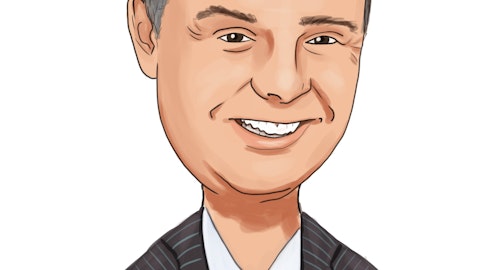Roberto Herencia: I think, to add to what Tom said. And I think the point that he said kind of like in between is like. I think that guide is — goes beyond the quarter. Just think of that also kind of going into 2024. So if you, kind of, take the, call it, the run rate adjusted for charges and you take that run rate on the guide with that range. I think what you’re seeing there is probably just an update into next year that — I mean, I’m sure you can kind of do the back of the envelope there. But that’s just inflation and probably just also incorporate some of the growth that we’re seeing into next year.
Damon DelMonte: Got it. Okay. That’s helpful. And I guess, just lastly, kind of broader speaking on credit. You know any updated thoughts on particular areas of your footprint or the portfolio where you might be seeing some softening or you’re keeping a more watchful eye?
Roberto Herencia: Other than the office space, obviously, we haven’t seen any trends in the other asset classes that we currently have in the portfolio. We’re spending a lot of time being vigilant, doing our portfolio reviews. We’re focused on solutions when we do have problems. And our business units have been — they’ve been very good about staying in touch with the customers and looking for any science-based at problems.
Damon DelMonte: Got it. Okay. Thank you very much. Appreciate all the color. It’s all that I had.
Roberto Herencia: Thank you.
Alberto Paracchini: Thanks, Damon.
Operator: The next question comes from Terry McEvoy from Stephens Inc. Terry, your line is open. Please go ahead.
Terry McEvoy: Hi. Good morning, everyone.
Roberto Herencia: Good morning, Terry.
Alberto Paracchini: Good morning, Terry.
Terry McEvoy: And thanks for the appendix slide, very, very helpful. I don’t have to ask Tom the accretion question. So thanks for that. Maybe just stepping out of the model a little bit. You’ve got — we’re hearing larger players in Chicago are shrinking or deemphasizing certain areas. So are you getting more incoming calls from lenders? And how are you thinking about kind of playing more offense, given some of the changes in the competitive landscape that I’m hearing about?
Roberto Herencia: I think probably, Terry, in general terms, it’s — what we’re seeing is a lot of the so-called risk-weighted asset diets that some of the larger players are kind of going through. A lot of what we’re seeing is initially, those seem to be very much on transactional-driven business. So not necessarily — we’re not necessarily — we’re not in a lot of those businesses. We — as you well know, we don’t have a significant consumer business. We’re not in the mortgage space. So we’re not really, kind of, seeing opportunities to kind of pick up where others maybe that are more capital constrained are looking to lighten up on risk-weighted assets. We’re more focused on opportunities where it’s relationship driven. What we are seeing though in the market is more and more, particularly some of the larger players looking to participate or syndicate transactions and actually be willing to offer more of the relationship to others in order to entice them to participate.
And that’s a mark change from what we had seen in the past. But again, it’s not necessarily something that we are — it’s not necessarily something that we do on a day-to-day basis. I would say we just are really, really focused on the entire relationship, building relationships and focusing on customer dislocation as a result of mergers and transactions that have happened here in the past. So to answer your question directly, yes, we’re seeing some of it not necessarily in areas where we really would be looking to capitalize on.
Terry McEvoy: Perfect. And then as a follow-up question, I don’t think anybody should be surprised on Page 17, the office portfolio metrics with NPL delinquencies criticized higher in the quarter. So I guess my question is if I go back to Slide 16, are there any other areas within CRE, retail or senior housing where you have maybe an upward migration in some of those credit stats, but just not to the degree that we’re seeing in office, or are those portfolios still performing, I guess, the trends are relatively stable.



